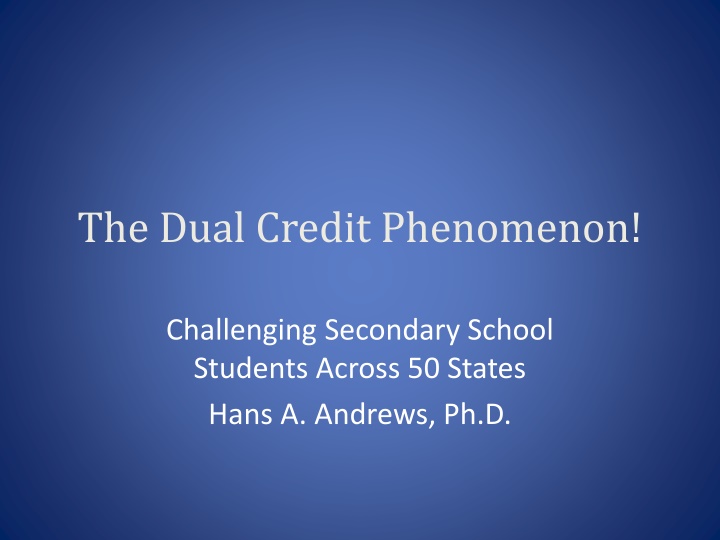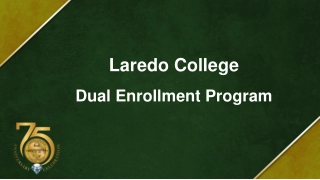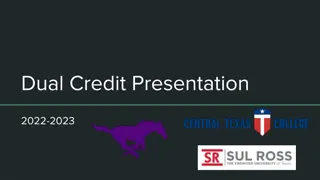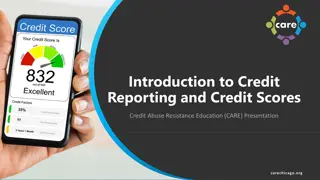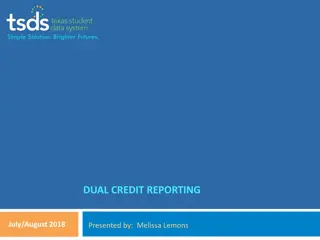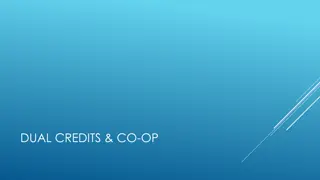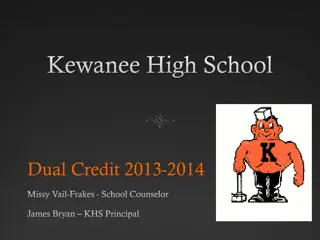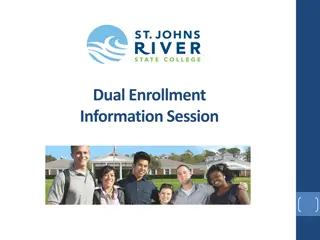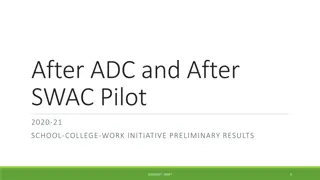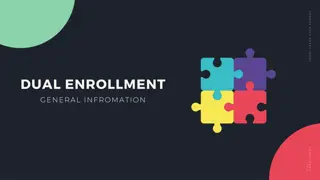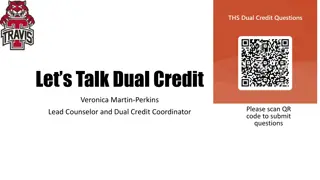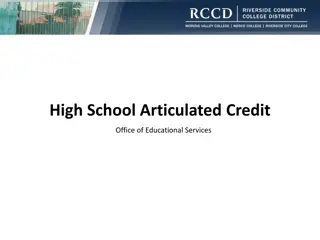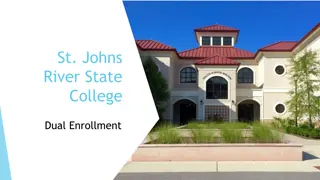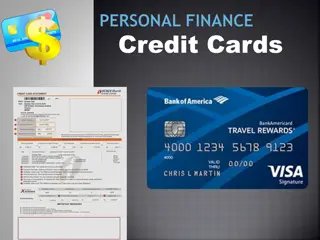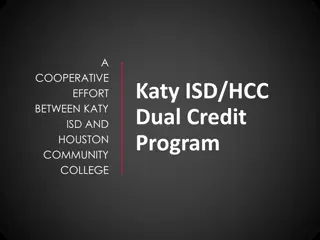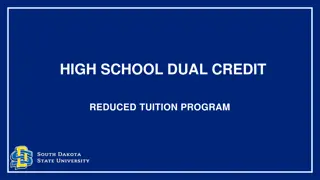Dual Credit Programs for High School Students
Dual credit programs, also known as concurrent enrollment, offer high school students the opportunity to earn college credits while still in secondary school. This innovative approach enhances academic readiness, shortens the time needed to complete an undergraduate degree, and provides a seamless transition to higher education. Through partnerships with accredited universities, students receive letter grades, benefit from expert instruction, and adhere to rigorous academic standards set by organizations like NACEP.
Download Presentation

Please find below an Image/Link to download the presentation.
The content on the website is provided AS IS for your information and personal use only. It may not be sold, licensed, or shared on other websites without obtaining consent from the author.If you encounter any issues during the download, it is possible that the publisher has removed the file from their server.
You are allowed to download the files provided on this website for personal or commercial use, subject to the condition that they are used lawfully. All files are the property of their respective owners.
The content on the website is provided AS IS for your information and personal use only. It may not be sold, licensed, or shared on other websites without obtaining consent from the author.
E N D
Presentation Transcript
The Dual Credit Phenomenon! Challenging Secondary School Students Across 50 States Hans A. Andrews, Ph.D.
What is Dual Credit? Also called concurrent enrollment, dual credit was designed: to smooth the transition from high school to college Shorten the time needed to earn an undergraduate degree; Improve the study habits, general academic readiness and academic options for college- bound students.
Why Dual Credit? Students earn letter grades recorded at an accredited university. Courses taught by master instructors mentored by university faculty. Class syllabi ensure a broad, subject-based curriculum. University partner is directly accountable to uphold state and national standards
NACEP National Alliance of Concurrent Enrollment Partnerships A national network of educators, advocates and champions of student success K- 20 Serves as a national accrediting body for programs by providing standards of excellence, current research and national trends 15 academically-driven standards expectations that programs are expected to practice in the areas of Curriculum alignment Faculty Development Student Assessment Student Services Program evaluation
In addition.. Eleven (11) states have adopted legislation that looks like this: All postsecondary institutions and campuses offering dual credit courses on a high school campus, taught by high school instructors, must be a a fully- accredited member of NACEP in order that those courses be considered for transfer to state institutions of higher education. Beginning in the fiscal year 2011, only secondary school districts with NACEP- accredited higher education partners are eligible for state aid. The Dual Credit Task Force Report to the General Assembly recommends requiring all institutions offering dual credit programs to comply with added criteria adapted from those used by the NACEP for accrediting dual credit programs.
National Supporting Research* Jobs for the Future Institute for Higher Education Policy National Center for Restructuring Education, Schools & Teaching, Columbia University Center for Science, Technology & Public Policy Woodrow Wilson National Fellowship Foundation Pew Foundation Bill & Melinda Gates Early College Initiative Published Research from 17 NACEP-accredited institutions *WARNING Reading may cause other advance placement programs to become obsolete!
Harlan Cotter, IL Superintendent If our students are to be prepared academically and financially for post- secondary experiences, dual-credit opportunities must be made more available. . . What is available at UMKC for students at Smithville High School?
A Nationally Accredited Higher Education Partner As the world continues to shrink to one global village, the future will belong to the educated. The leading schools will be those that take full advantage of high school and college resources and have the courage to use those resources by implementing dual credit partnerships
University of Missouri-Kansas City High School/College Partnerships Celebrating Thirty Years of Course Integrity and Student Success www.umkc.edu/hscp
Frequently Asked Questions
When is UMKCs tuition due? On the 20th of each month
Do We have to pay tuition all at once? No, but pay the amount you have budgeted by the due date to avoid late fees and carrying charges. 1. Students will outstanding balances for a previous semester will not be allowed to register for courses in a new semester. 2. Transcripts will not be released if students have unpaid balances on their accounts.
How is credit issued/recorded? Students earn credit for UMKC coursework in a 3-step process: 1. Gain Admission to UMKC (on-line app posted each semester on the HSCP web site) 2. Complete the instructor s Application to Register for a UMKC course for dual credit 3. Complete the class. Grades are recorded on the student s transcript at UMKC and may be viewed by students in the UMKC Pathway system at any time.
How many credits does my child receive? Credit attributes for each course is shown on the registration form for the course; for example: History 101: American Survey to 1877 (3 credit hours) Chemistry 211/211L: General Chemistry I/Experimental General Chemistry Lab (5 credit hours)
What is a credit in college? Most 4-year institutions require 120 credits in the student-selected major to complete a baccalaureate (BA or BS) degree.
Will UMKC credits transfer? Credits don t transfer; Courses do. 1. Check the equivalency tables at the receiving university for courses that transfer. 2. Before meeting with the academic advisor at the receiving university, request that your university transcript be sent to avoid repeating coursework. 3. Learn the language, Does ABC honor UM System courses in transfer? not Do you accept dual credit courses? 4. KEEP A PORTFOLIO OF UNIVERSITY COURSEWORK!!!!!!!!! 5. Advocate for yourself and be prepared to demonstrate proof of mastery university-provided official transcript; student- provided course syllabus, course description, course portfolio.
What is the benefit of me paying for this now when I can get it for free next year using A+? What is what? What is A+? What is your academic plan? What degree do you seek? What remedial courses will you need in order to be accepted into the post-secondary institution of choice? What fees will the student be responsible for paying in an A+ program textbooks?
What does AP mean? A designator for a course whose curriculum has been approved by the College Board. At the conclusion of the course, the CB s standardized AP test is given. AP courses are given attention in national media such as Newsweek to be the most rigorous classes in US high schools today.
Why Advanced Placement? Gives students an advantage in selection pool at competitive colleges/universities Preparation for the AP Exams teach students how to prepare for college-level courses AP Exams demand college-level writing
Is AP credit better than dual credit? What s the difference? It is not possible to make a comparison two very different options. Smithville High School s course offerings combine two highly advantageous programs. Dual Credit through partnership with UMKC Potential for additional credit to be earned on AP exam
